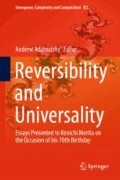Abstract
We design a logic circuit that is capable of converting from a one-digit decimal number to equivalent four-bit binary number. The circuit is composed by reversible elements each of which takes an equal number of input and output lines, associated with a memory to store a binary state. Reversible elements, as claimed by Morita, (International Conference on Machines, Computations, and Universality, 2001) [8], allow more straightforward and efficient constructions of circuits than conventional reversible logic gates. In particular, the circuit is invertible in the sense that reversing the functionalities of each element in it directly gives rise to another circuit which conducts the inverse conversion.
Access this chapter
Tax calculation will be finalised at checkout
Purchases are for personal use only
References
Bhattacharya, J., Gupta, A., Singh, A.: A high performance binary to BCD converter for decimal multiplication. In: International Symposium on VLSI Design Automation and Test, pp. 315–318 (2010)
Fredkin, E., Toffoli, T.: Conserv. log. J. Theor. Phys. 21(3–4), 219–253 (1982)
Hauck, S.: Asynchronous design methodologies: an overview. Proc. IEEE 83(1), 69–93 (1995)
Hopcroft, J.E., Ullman, J.D.: Introduction to Automata Theory, Languages, and Computation. Addison-Wesley, Boston (1979)
Lee, J., Adachi, S., Xia, Y.N., Zhu, Q.S.: Emergence of universal global behavior from reversible local transitions in asynchronous systems. Inf. Sci. 282, 38–56 (2014)
Lee, J., Peper, F., Adachi, S., Morita, K.: An asynchronous cellular automaton implementing 2-state 2-input 2-output reversed-twin reversible elements. In: International Conference on Cellular Automata for Research and Industry, pp. 67–76 (2008)
Lee, J., Yang, R.L., Morita, K.: Design of 1-tape 2-symbol reversible turing machines based on reversible logic elements. Theor. Comput. Sci. 460(1), 78–88 (2012)
Morita, K.: A simple universal logic element and cellular automata for reversible computing. In: International Conference on Machines, Computations, and Universality (2001)
Morita, K.: Reversible computing and cellular automata – a survey. Theor. Comput. Sci. 395(1), 101–131 (2008)
Rhyne, V.T.: Serial binary-to-decimal and decimal-to-binary conversion. IEEE Trans. Comput. C-19(8), 808–812 (1970)
Tang, M.X., Lee, J., Morita, K.: General design of reversible sequential machines based on reversible logic elements. Theor. Comput. Sci. 568, 19–27 (2015)
Toffoli, T.: Reversible computing. In: de Bakker, J., van Leeuwen J (eds.) Automata, Languages and Programming. LNCS, vol. 85, pp. 632–644 (1980)
Acknowledgements
We are grateful to Prof. Kenichi Morita at Hiroshima University, Japan, for the valuable guidance and advice. This research work was supported by International Exchange Program of National Institute of Information and Communications (NICT), and Natural Science Foundation of Chongqing (No. cstc2016jcyjA1315).
Author information
Authors and Affiliations
Corresponding author
Editor information
Editors and Affiliations
Appendix
Appendix
To verify the correctness of the construction in Fig. 6, the following figures illustrate the major steps in converting the decimal number 9 to binary bits 1001 by the Invertible decimal-to-binary converter.
-
(1)
The Invertible decimal-to-binary converter receives a token from input line \(D_9\) that encodes the number 9. Initially, all elements are in state 0, with their states being explicitly denoted in each element.
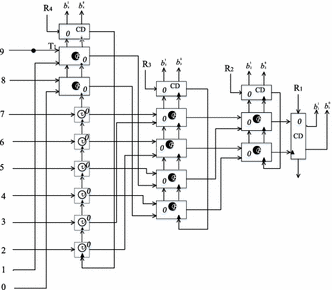
-
(2)
The 4th (most significant) bit of the number 9 (1001) is extracted and encoded by the state of the leftmost CD. The token is transferred on the line representing the binary bits 001.
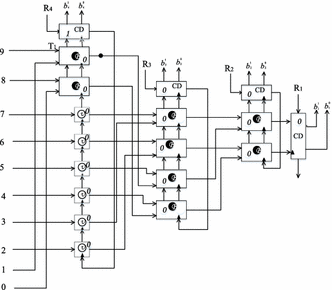
-
(3)
The 3rd bit of the number 9 (1001) is extracted and encoded by the state of the corresponding CD. The token appears on an interconnection line encoding the binary bits 01.
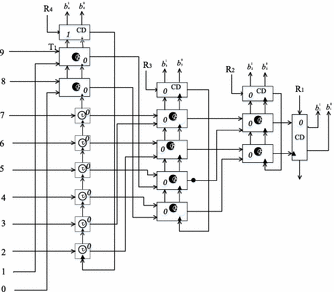
-
(4)
The 2nd bit of the number 9 (1001) is extracted and encoded by the state of the corresponding CD. The token runs on a line representing the binary number 1.
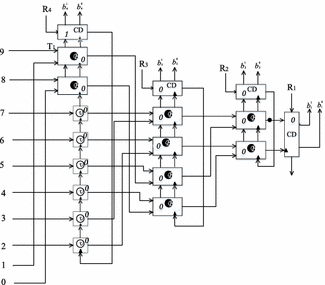
-
(5)
The lowest bit of the number 9 (1001) is extracted and encoded by the state of the rightmost CD. Finally, a token appears on the output line S of the construction, which shows the completion of the conversion process.
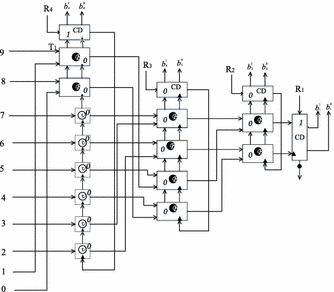
Rights and permissions
Copyright information
© 2018 Springer International Publishing AG
About this chapter
Cite this chapter
He, TR., Lee, J., Isokawa, T. (2018). Invertible Construction of Decimal-to-Binary Converter Using Reversible Elements. In: Adamatzky, A. (eds) Reversibility and Universality. Emergence, Complexity and Computation, vol 30. Springer, Cham. https://doi.org/10.1007/978-3-319-73216-9_7
Download citation
DOI: https://doi.org/10.1007/978-3-319-73216-9_7
Published:
Publisher Name: Springer, Cham
Print ISBN: 978-3-319-73215-2
Online ISBN: 978-3-319-73216-9
eBook Packages: EngineeringEngineering (R0)

